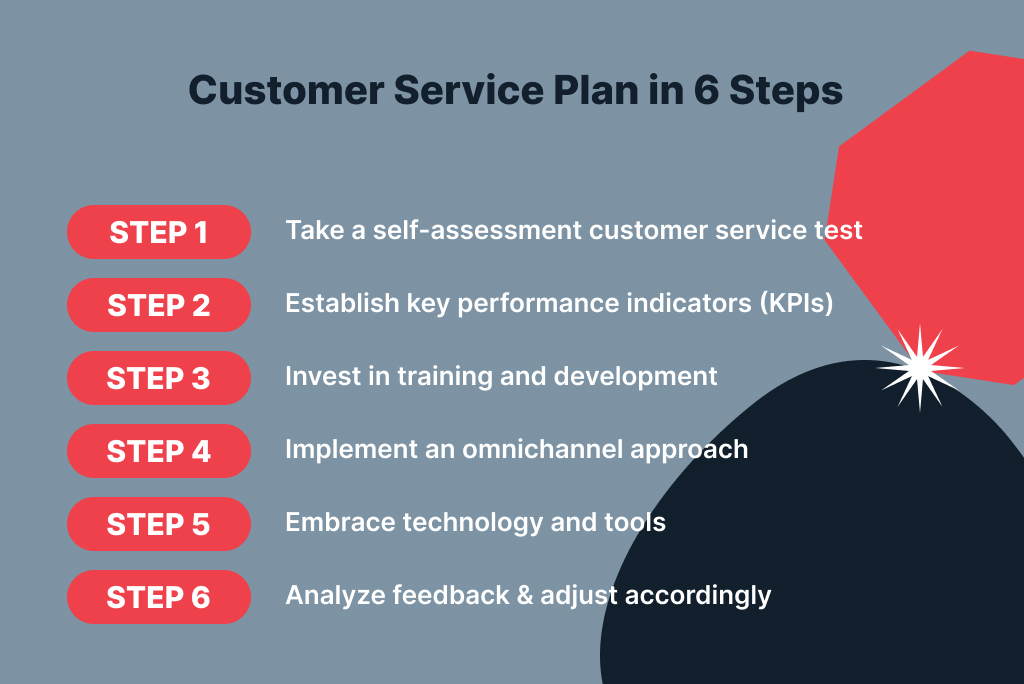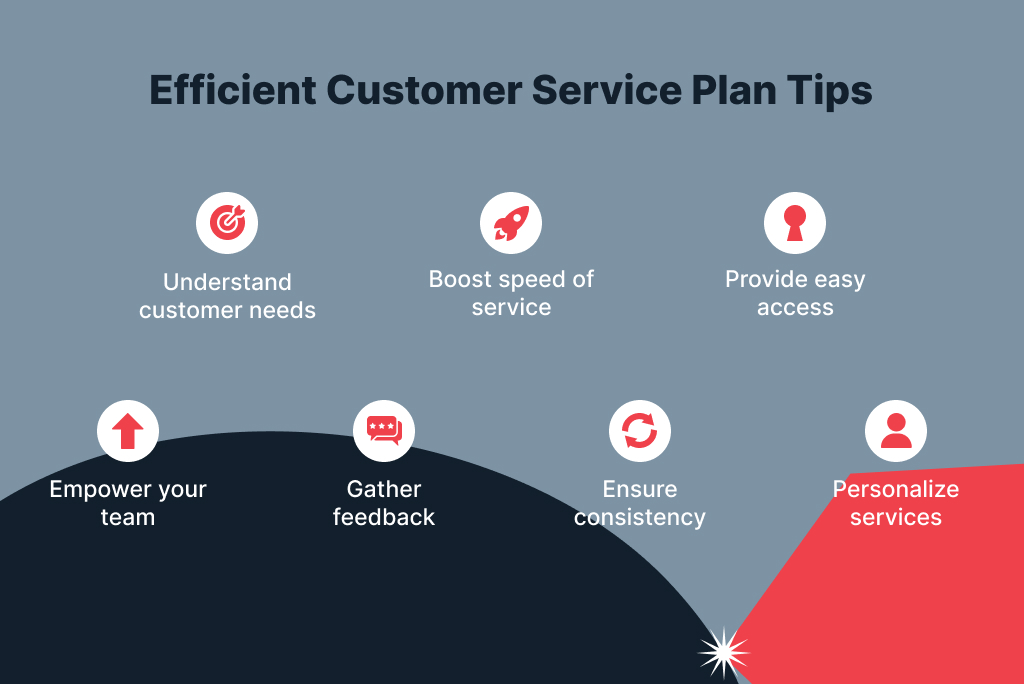We offer the expertise and support to do just that. Contact us for comprehensive customer support services that will set your brand apart.

Having a customer care plan is important because it helps businesses efficiently manage their customers. Still, many people hesitate to create a customer care plan because they may think it's time-consuming or unnecessary.
In reality, creating a customer service plan is simpler than it seems. Our guide will help you understand what is a customer service plan and how to build one that fits your business needs. Plus, we've included templates and examples to help you easily tailor your plan.

What is customer care plan and its importance?
To understand the importance, you first need to know what is customer service plan. A customer care plan outlines a company's approach to supporting and valuing its customers. It details how the business will listen to, assist with issues, and prioritize the satisfaction of its customers.
This plan typically involves a dedicated team to address customer inquiries, streamline the support process, and ensure customer satisfaction with the company's products or services.
Companies develop customer care plans to foster strong relationships with their customers.
A customer care plan is also important because it:
- Sets clear goals for customer support.
- Ensures a company-wide commitment to customer satisfaction.
- Communicates with customers clearly and provides timely, accurate information.
- Trains employees in effective customer service and promotes ongoing learning.
- Gathers and acts on customer feedback to improve services.
- Empower employees to resolve customer issues with confidence.
- Maintains consistent quality in customer experiences across all contact points.
- Resolves customer issues swiftly to ensure satisfaction.
- Leverages technology for efficient and organized communication.
- Proactively addresses potential problems before they escalate.
- Enables customers to find solutions independently.
- Regularly reviews and adjusts the plan based on its effectiveness in achieving customer happiness.
Implementing a comprehensive customer care plan might seem daunting, but it's achievable. By considering all aspects, you can develop a plan that meets the needs of your customers, employees, and business, paving the way for success.
How to create a customer service plan step by step?
To develop an effective customer service business plan, start by evaluating how much your company values customer satisfaction. Begin with a thorough self-assessment to gauge your organization's dedication to making customers happy.

Step 1: Take a self-assessment customer service test
In the book, The Customer-Driven Company by Richard C. Whiteley, the author discusses a self-assessment customer service test that helps businesses understand how well they serve their customers.
Richard’s test is a good way to understand your customers’ needs, preferences, and pain points. It is like a set of questions or evaluations to check how well a company takes care of its customers. The goal is to figure out where the company excels and where it can make improvements.
There are five ratings to determine the quality of service your business provides to customers. These are:
- Are you kidding? (Lowest rating)
- Hardly ever
- Sometimes
- Usually
- It’s our way of life! (highest rating)
Strive for a score of 4 or 5, indicating your business prioritizes and excels in customer service.
The self-assessment customer service test
This test includes various questions designed to give you a clearer insight into your customer service strategy.
It covers key areas such as commitment to service culture, alignment with customer needs, problem-solving skills, effective management of customer data, outreach efforts, the competence and empowerment of your team, and ongoing enhancement of your offerings and procedures.
Here is a table to help you take Richard's test hassle-free. After each statement, give a rating from 1-5 (the ones provided above). Then, divide the total score with the total number of questions to find the exact rating.
| Our culture | Rating (1-5) |
| 1. We’re committed to doing whatever it takes to create satisfied customers. | (____) |
| 2. We strive to do things right the first time. | (____) |
| 3. As the owner, I exemplify that customer service is important. | (____) |
| 4. Serving our customers’ needs takes priority over meeting our internal needs. | (____) |
| Total Score divided by 4 | ____ |
| Customer alignment | Rating (1-5) |
| 1. When we sell, we aim for a partnership approach. | (____) |
| 2. In our marketing materials, we don’t promise what we can’t deliver. | (____) |
| 3. We understand the features and benefits that matter most to our customers. | (____) |
| 4. We design new products/services based on information provided by our customers. | (____) |
| Total Score divided by 4 | ____ |
| Problem-solving | Rating (1-5) |
| 1. We review customer complaints. | (____) |
| 2. We constantly ask our customers for feedback. | (____) |
| 3. We regularly look for ways to eliminate errors based on customer input. | (____) |
| Total Score divided by 3 | ____ |
| Using customer information | Rating (1-5) |
| 1. We’ve determined what our customers expect from us. | (____) |
| 2. We frequently interact with our customers. | (____) |
| 3. All employees know what’s important to our customers. | (____) |
| Total Score divided by 3 | ____ |
| Customer outreach | Rating (1-5) |
| 1. We make it easy for our customers to deal with us. | (____) |
| 2. We aim to resolve all customer complaints. | (____) |
| 3. We encourage "wowing the customer." | (____) |
| Total Score divided by 3 | ____ |
| Qualified and empowered staff | Rating (1-5) |
| 1. I respect my employees. | (____) |
| 2. All employees firmly understand our product/service. | (____) |
| 3. All employees possess the right tools and skills to perform their jobs well. | (____) |
| 4. All employees are encouraged to resolve customer issues. | (____) |
| 5. All employees feel that customer satisfaction is part of their job. | (____) |
| Total Score divided by 5 | ____ |
| Improving products/services and processes | Rating (1-5) |
| 1. We constantly work to improve our processes and products. | (____) |
| 2. Company units communicate and cooperate to solve problems and accomplish objectives. | (____) |
| 3. When we uncover problems, we try to resolve them quickly. | (____) |
| Total score divided by 3 | ____ |
After you complete the test, review your score to see if it's high or low.
A low score indicates that your customer service can be improved. Focus on the lower-score areas and consider ways to enhance them, such as additional training or modifying your procedures.
If your score is high, that's excellent! It means you're excelling at prioritizing your customers. Now, you're ready to proceed to the second step of developing your customer service strategy.
Step 2: Establish key performance indicators (KPIs)
To gauge the effectiveness of your customer service strategy, it's essential to monitor specific Key Performance Indicators (KPIs). These indicators provide insights into customer satisfaction and the performance of your support team.
Important KPIs to track include customer satisfaction scores (CSAT), net promoter scores (NPS), resolution times, and first-contact resolution rates.
However, we recommend you establish all the following KPIs to do customer service planning better:
- CSAT: Measures how happy customers are with the support they received.
- NPS: Indicates whether customers are likely to recommend your service to others.
- Resolution Times: Tracks how quickly your team resolves issues, which is crucial for customer satisfaction.
- First-Contact Resolution Rate: Determines how often problems are solved on the first interaction with a customer.
- Abandon Rate: The frequency at which customers abandon their support requests. A high rate suggests issues with the support process.
- Cost per Resolution: Evaluates the efficiency of your resources in resolving customer issues.
- Customer Lifetime Value: Estimates the total profit a customer will bring over their relationship with your company, indicating long-term satisfaction and value.
- Conversion Rate: Measures the effectiveness of turning visitors into paying customers, indicating the success of your customer acquisition and retention strategies.
- Escalation Rate: Identifies the proportion of service requests that require advanced support beyond the initial level.
- Repurchase Rate: The likelihood of customers making repeat purchases, signaling their loyalty and satisfaction with your products or services.
Step 3: Invest in training and development
Once you've established standards and set KPIs for your business, the next crucial step is investing in ongoing team training. This ensures that your customers always receive top-notch support.
Here are some simple strategies we use for agent training at our inbound call center outsourcing company—and recommend you use:
- Teach your team essential skills such as effective problem-solving, clear communication, and in-depth product knowledge.
- Tailor the training to meet their needs, including how to manage difficult situations.
- Encourage continuous learning through online courses or workshops.
- Use technology to make learning engaging and accessible, and seek feedback to improve training sessions.
- Ensure your team has comprehensive knowledge of your products, enabling them to assist customers more effectively.
- Recognize and appreciate your employees' efforts. Praise those who excel in training and keep sessions concise and engaging.
- Stay informed about the latest industry trends so your team can provide the best possible support to customers.
By focusing on these areas, you can enhance your team's performance and ensure they are well-equipped to meet your customers' needs.
At Simply Contact, we strongly emphasize continuous training and development, ensuring that each agent is thoroughly prepared before starting a project. Our approach includes specialized training sessions tailored to both call center projects for startups and enterprises. This equips our agents with the necessary skills and knowledge to provide exceptional customer service.
This commitment to ongoing education and improvement is a cornerstone of our approach. It enables us to deliver high-quality support and maintain our reputation as a trusted partner in customer service solutions.
Step 4: Implement an omnichannel approach
An omnichannel strategy ensures customers enjoy a seamless experience, whether interacting with a company online, over the phone, or in person. To achieve this, identify various channels through which customers can reach you, such as phone, email, live chat, and social media.
Develop plans to ensure a consistent experience across all these channels. This means customers should expect the same quality of service, no matter how they contact you.
Take Simply Contact as an example. We aim to provide a smooth and effortless experience for customers, regardless of their preferred contact method. We recognize the value of omnichannel support and offer various ways for customers to get in touch, including online, by phone, or through other means like email, live chat, and social media.
Step 5: Embrace technology and tools
In today's fast-paced world, staying updated with the latest technology is crucial. For a customer service business, it's essential to implement a robust customer relationship management (CRM) system, ticketing software, and chatbots.
These tools streamline your team's work. A CRM system organizes customer information efficiently, ticketing software tracks customer inquiries, and chatbots provide instant responses to frequently asked questions.
At Simply Contact, we're ahead of the curve, utilizing advanced software and chatbots to simplify our contact center services. Our automation means routine tasks are managed automatically, freeing up your team to tackle more complex issues.
Step 6: Analyze feedback & adjust accordingly
Analyzing feedback helps you identify areas for improvement and highlights what your business is doing well.
Make it a habit to Gather feedback from your customers. Use surveys, reviews, and social media monitoring to get a sense of their experiences. Also, frequently check your customer service plan and key performance indicators (KPIs) to see if you're meeting your goals and adjust your approach if necessary.
7 tips to create an efficient customer service plan
Keep these tips in mind to develop an effective customer service plan and build strong relationships with your customers:

- Understand your customers' needs to tailor your customer service planning to their concerns effectively.
- Train your team to be approachable and quick in responding to customer inquiries; this fosters positive interactions.
- Ensure your customers can easily access information about your products or services for a seamless experience.
- Empower your team with the authority and tools they need to resolve issues promptly, reducing the need for escalation.
- Feedback is crucial! Set up a system for customers to share their thoughts, helping you recognize your strengths and areas for improvement.
- Aim for consistent service quality in all customer interactions to establish a dependable and trustworthy reputation.
- Personalize your interactions by considering each customer's preferences and history, demonstrating that you value their business and fostering a positive relationship.
Customer service plan template
This template is designed to help you quickly set up your customer service.
Note: For step 1 (the self-assessment test), you can print out the test as it is mentioned earlier in this guide.
| Establish key performance indicators (KPIs) | |
| Customer satisfaction score (CSAT) | ____% |
| Net promoter score (NPS) | ____ (on a scale of -100 to 100) |
| Resolution time | ____ hours |
| First contact resolution rate | ____% |
| Abandon rate | ____% |
| Cost per resolution | ____$ |
| Invest in training and development |
| Train employees on problem-solving, effective communication, and product knowledge. |
| Customize training to address specific needs, such as handling tricky situations. |
| Encourage continuous learning through online classes, workshops, and other avenues. |
| Use technology to enhance training effectiveness. |
| Ensure employees have a comprehensive understanding of the products/services. |
| Implement an omnichannel approach |
| Identify various channels for customer contact: ⬩ Phone ⬩ Live chat ⬩ Social media (add according to your preference) |
| Develop strategies to provide a consistent experience across all channels. |
| Prioritize seamless and hassle-free customer interactions. |
| Embrace technology and tools |
| Utilize a robust Customer Relationship Management (CRM) system. |
| Implement ticketing software for efficient issue tracking and management. |
| Integrate chatbots to quickly address common customer queries. |
| Automate routine tasks to optimize team efficiency. |
| Analyze feedback & adjust accordingly |
| Conduct surveys, reviews, and social media monitoring to get feedback. |
| Review customer service business plans and KPIs. |
| Make adjustments based on feedback and changing business objectives. |
Customer service plan example
Here's a simple example of what is customer service plan:
Self-Assessment Customer Service Quotient
- Cultural Commitments Rating: 4.5/5
- Customer Alignment Rating: 3.8/5
- Problem Solving Rating: 4.2/5
- Using Customer Information Rating: 4.6/5
- Customer Outreach Rating: 3.9/5
- Qualified and Empowered Staff Rating: 4.4/5
- Improving Products/Services and Processes Rating: 4.1/5
Final Rating: 4.2/5
This rating states that the following areas need improvement:
- Customer Alignment
- Customer Outreach
Action steps to enhance these areas:
- Conduct targeted training sessions for the sales and marketing teams to ensure a better alignment with customer expectations in product/service delivery.
- Implement a customer feedback system to gather insights on their preferences and expectations.
- Do collaboration between customer service and product development teams to streamline processes based on customer feedback.
- Establish regular forums for direct interaction between customers and the company, providing insights into their experiences and expectations.
- Provide additional training to staff, focusing on the importance of customer-centric approaches in their daily interactions and decision-making processes.
Key Performance Indicators (KPIs)
- Customer Satisfaction Scores (CSAT): 90%
- Net Promoter Scores (NPS): 75
- Resolution Times: 4 hours
- First-Contact Resolution Rate: 92%
- Abandon Rate: 5%
- Cost per Resolution: $20
- Customer Lifetime Value: $500
- Conversion Rate: 15%
- Escalation Rate: 3%
- Repurchase Rate: 80%
Training and development – action steps
- Assess current employee skills in problem-solving, communication, and product knowledge.
- Design training programs to address identified skill gaps.
- Introduce an online learning platform with diverse courses.
- Employ interactive tools and simulations for real-life learning experiences.
- Set up a system for giving constructive feedback and recognizing outstanding performers.
Implement an omnichannel approach – action steps
- Identify key communication channels preferred by the target audience, such as phone, email, live chat, and social media.
- Ensure a consistent brand message and customer service strategy across all channels.
- Train staff to manage interactions seamlessly across various platforms.
- Implement a unified customer database to keep information synchronized across channels.
- Create a customer feedback loop to monitor and improve customer experiences, adjusting the omnichannel strategy as needed.
Embrace technology and tools – action steps
- Integrate a robust Customer Relationship Management (CRM) system to centralize customer data, track interactions, and improve management.
- Utilize a ticketing system for efficient issue tracking, prioritization, and resolution.
- Integrate chatbots to handle routine queries and provide instant responses.
Analyze feedback & adjust accordingly – action steps
- Consistently gather customer feedback using surveys, reviews, and by monitoring social media to gauge their experiences.
- Regularly review the company's customer service strategy and key performance indicators (KPIs) to verify they align with set goals.
- Identify areas for improvement and acknowledge what the company is doing well based on customer feedback.
- Adjust the company's approach as needed to better meet customer expectations and improve their overall experience.

Conclusion
In conclusion, creating a comprehensive customer service business plan is essential for any business aiming to deliver exceptional service and build lasting relationships with its customers. If you're still unsure what is a customer service plan, this guide has helped outline the structure and value behind it. Your business can consistently meet and surpass customer expectations by evaluating current practices, embracing an omnichannel strategy, utilizing technology, and refining your approach based on feedback.
For many companies, a strategic way to strengthen service delivery is to outsource help desk functions to a trusted partner. This approach ensures customers receive expert, round-the-clock support while your internal team focuses on core priorities.
Remember, the key to successful customer care lies in understanding your customers' needs, being responsive to their feedback, and being willing to adapt your strategies to better serve them.
FAQ
What’s the difference between a customer service plan and a customer support strategy?
Customer service plans outline the operational details of support activities, including roles and responsibilities, communication channels, and performance evaluation methods. The document serves as your operational blueprint for delivering consistent service.
A customer support strategy outlines the strategic direction that connects business objectives to customer experience improvement and long-term development. Strategy establishes the direction, while the plan is a roadmap.
How often should a customer service plan be reviewed or updated?
A customer service development plan should be reviewed or updated at least every six months. This ensures that your plan adapts to changing customer needs, new technology, and internal feedback. If you’re growing fast or introducing new products, consider updating your plan more frequently.
Can a small business benefit from a customer service plan template?
Yes, especially small businesses. A customer support plan template enables easy setup and prevents necessary steps from being overlooked. The template reduces time requirements while providing structure to deliver dependable, high-quality support to smaller teams that do not need to create a plan from scratch.
What KPIs should be included in a customer service development plan?
The correct KPIs demonstrate whether your customer support plan achieves its goals. Include:
- Customer satisfaction score (CSAT): Tracks customer happiness after support.
- The Net Promoter Score (NPS) evaluates customer loyalty and willingness to recommend the company.
- Average resolution time: Monitors how fast issues are resolved.
- First-contact resolution rate: Evaluates how often problems are solved immediately.
- Abandon rate: Shows how many customers drop out before getting help.
- Cost per resolution: Helps assess operational efficiency.
- Customer lifetime value (CLV) calculates the total revenue from each customer throughout their lifetime.
- Conversion rate: Measures how well support drives sales.
- Escalation rate: Reveals the percentage of cases needing higher-level attention.
- Repurchase rate: Reflects repeat customer behavior and loyalty.
The KPIs in your customer service development plan maintain focus while providing measurable results.
Who should be involved in building a customer care plan?
Multiple departments need to participate in creating an effective customer support plan.
- Customer support leaders: Establish the organizational structure and performance requirements.
- Frontline agents: Share real insights from daily interactions.
- Sales and marketing teams: Align messaging and promises with service delivery.
- Product teams: Adapt products based on customer input.
- Executives: Provide strategic direction and resources.
Your customer service plans will become realistic, scalable, and actionable through the collaborative involvement of all stakeholders.
Get fast answers to any remaining questions
Thank you.
Your request has been sent successfully.
Your request has been sent successfully.






